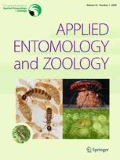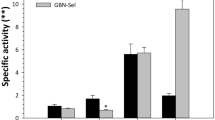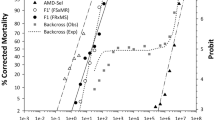Abstract
The tomato leafminer, Tuta absoluta (Meyrick), is one of the most destructive pests of tomato worldwide. T. absoluta has developed resistance to a wide range of insecticides in the field. This study aimed to assess the baseline toxicity of field populations of T. absoluta to flubendiamide and chlorantraniliprole, diamide insecticides recently registered to control the pest in Kuwait. Subsequently, the risk of resistance evolving as well as inheritance of resistance to the insecticides was investigated. The susceptibility variation among the populations tested was low (threefold for flubendiamide and fourfold chlorantraniliprole). The LC50 values for flubendiamide ranged from 0.04 to 0.11 mg L−1, whereas the LC50 values for chlorantraniliprole ranged from 0.29 to 1.13 mg L−1. After 34 generations of selection, 750- and 860-fold increases in resistance were recorded for flubendiamide and chlorantraniliprole, respectively. The realized heritability (h2) of resistance was estimated as 0.21 for flubendiamide and 0.29 for chlorantraniliprole, using threshold trait analysis. The values of the response quotient (Q) for resistance against flubendiamide and chlorantraniliprole were 0.11 and 0.13, respectively. We discussed our results with regard to the development of diamide resistance in T. absoluta, the potential spread of resistance, and strategies to mitigate the evolution of resistance.

Similar content being viewed by others
References
Abbott WS (1925) A method of computing the effectiveness of an insecticide. J Econ Entomol 18:265–267
Ayalew G (2015) Efficacy of selected insecticides against the South American tomato moth, Tuta absoluta Meyrick (Lepidoptera: Gelechiidae) on tomato in the Central Rift Valley of Ethiopia. Afr Entomol 23:410–417
Biondi A, Guedes RNC, Wan F, Desneux N (2018) Ecology, worldwide spread, and management of the invasive South American tomato pinworm, Tuta absoluta: past, present, and future. Annu Rev Entomol 63:239–258
Brown A (1977) Resistance as a factor in pesticide management. XV International Congress of Entomology, 19–27 August 1976. DC, USA, Washington, pp 816–824
CABI/EPPO. Tuta absoluta distribution map (2013) Wallingford, UK Center for Agriculture and Biosciences International, Map 723 (2nd revision)
Campos MR, Rodrigues ARS, Silva WM, Silva TBM, Silva VRF, Guedes RNC, Siqueira HAA (2014) Spinosad and the tomato borer Tuta absoluta: a bioinsecticide, an invasive pest threat, and high insecticide resistance. PLoS ONE 9:e103235
Campos MR, Silva TB, Silva WM, Silva JE, Siqueira HA (2015a) Spinosyn resistance in the tomato borer Tuta absoluta (Meyrick)(Lepidoptera: Gelechiidae). J Pest Sci 88:405–412
Campos MR, Silva TBM, Silva WM, Silva JE, Siqueira HAA (2015b) Susceptibility of Tuta absoluta (Lepidoptera: Gelechiidae) Brazilian populations to ryanodine receptor modulators. Pest Manage Sci 71:537–544
Campos MR, Biondi A, Adiga A, Guedes RNC, Desneux N (2017) From the Western Palaearctic region to beyond: Tuta absoluta ten years after invading Europe. J Pest Sci 90:787–796
Cifuentes D, Chynoweth R, Bielza P (2011) Genetic study of Mediterranean and South American populations of tomato leafminer Tuta absoluta (Povolny, 1994)(Lepidoptera: Gelechiidae) using ribosomal and mitochondrial markers. Pest Manag Sci 67:1155–1162
Cook DR, Leonard BR, Gore J, Temple JH (2005) Baseline responses of bollworm, Helicoverpa zea (Boddie), and tobacco budworm, Heliothis virescens (F.), to indoxacarb and pyridalyl. J Agric Urban Entomol 22:100–109
Cordova D, Benner EA, Sacher MD, Rauh JJ, Sopa JS, Lahm GP, Selby TP, Stevenson TM, Flexner L, Gutteridge S, Rhoades DF, Wu L, Smith RM, Tao Y (2006) Anthranilic diamides: a new class of insecticides with a novel mode of action, ryanodine receptor activation. Pest Biochem Physiol 84:196–214
Desneux N, Luna MG, Guillemaud T, Urbaneja A (2011) The invasive South American tomato pinworm, Tuta absoluta, continues to spread in Afro-Eurasia and beyond: the new threat to tomato world production. J Pest Sci 84:403–408
Desneux N, Wajnberg E, Wyckhuys KAG, Burgio G, Arpaia S, Narváez-Vasquez CA, González-Cabrera J, Catalán Ruescas D, Tabone E, Frandon J, Pizzol J, Poncet C, Cabello T, Urbaneja A (2010) Biological invasion of European tomato crops by Tuta absoluta: ecology, geographic expansion and prospects for biological control. J Pest Sci 83:197–215
Falconer DS, Mackay TF, Frankham R (1996) Introduction to quantitative genetics, 4th edn. Longman, New York
Finney D (1971) Probit Analysis, 3rd edn. Cambridge University Press, London
French-Constant RH (2007) Which came first: insecticides or resistance? Trends Genet 23:1–4
Guedes RNC (2017) Insecticide resistance, control failure likelihood and the first law of geography. Pest Manag Sci 73:479–484
Guedes R, Siqueira H (2012) The tomato borer Tuta absoluta: insecticide resistance and control failure. CAB Rev Perspect Agric Vet Sci Nutr Nat Resour 7:1–7
Guillemaud T et al (2015) The tomato borer, Tuta absoluta, invading the mediterranean basin, originates from a single introduction from Central Chile. Sci Rep 5:8371. https://doi.org/10.1038/srep08371
IRAC (2015) IRAC susceptibility test methods series: Method 022. Insecticide Resistance Action Committee. Available online: http://www.iraconline.org/content/uploads/Method_022_Tuta.pdf. Accessed 16 November, 2017
Jallow MF, Awadh DG, Albaho MS, Devi VY, Thomas BM (2017a) Pesticide risk behaviors and factors influencing pesticide use among farmers in Kuwait. Sci Total Environ 574:490–498
Jallow MF, Awadh DG, Albaho MS, Devi VY, Thomas BM (2017b) Pesticide knowledge and safety practices among farm workers in Kuwait: results of a survey. Int J Environ Res Public Health 14:340. https://doi.org/10.3390/ijerph14040340
Jallow MF, Awadh DG, Albaho MS, Devi VY, Ahmad N (2017c) Monitoring of pesticide residues in commonly used fruits and vegetables in Kuwait. Int J Environ Res Public Health 14:833. https://doi.org/10.3390/ijerph14080833
Karaagac SU (2015) Enzyme activities and analysis of susceptibility levels in Turkish Tuta absoluta populations to chlorantraniliprole and metaflumizone insecticides. Phytoparasitica 43:693–700
Klieber J, Reineke A (2016) The entomopathogen Beauveria bassiana has epiphytic and endophytic activity against the tomato leaf miner Tuta absoluta. J Appl Entomol 140:580–589
LeOra Software, POLO-Plus, POLO for windows computer program, version 2.0. LeOra- software (2005), Petaluma, California, USA
Megido RC, Haubruge E, Verheggen FJ (2013) Pheromone-based management strategies to control the tomato leafminer, Tuta absoluta (Lepidoptera: Gelechiidae): A review. Biotechnol Agron Soc Environ 17:475–482
Naselli M, Biondi A, Tropea Garzia G, Desneux N, Russo A, Siscaro G, Zappala L (2017) Insights on food webs associated with the South American tomato pinworm. Pest Manag Sci 73:1352–1357
Nauen R, Steinbach D (2016) Resistance to diamide insecticides in lepidopteran pests. In: Horowitz AR, Ishaaya I (eds) Advances in insect control and resistance management. Springer, Switzerland, pp 219–240
Robertson J, Preisler H, Ng S, Hickle LA, Gelernter W (1995) Natural variation: a complicating factor in bioassays with chemical and microbial pesticides. J Econ Entomol 88:1–10
Robertson JL, Savin N, Russell RM, Preisler HK (2007) Bioassays with arthropods. CRC Press, Boca Raton
Roditakis E, Skarmoutsou C, Staurakaki M (2013) Toxicity of insecticides to populations of tomato borer Tuta absoluta (Meyrick) from Greece. Pest Manag Sci 69:834–840
Roditakis E, Vasakis E, Grispou M, Stavrakaki M, Nauen R, Gravouil M, Bassi A (2015) First report of Tuta absoluta resistance to diamide insecticides. J Pest Sci 88:9–16
Roditakis E, Steinbach D, Moritz G et al (2017) Ryanodine receptor point mutations confer diamide insecticide resistance in tomato leafminer, Tuta absoluta (Lepidoptera: Gelechiidae). Insect Biochem Mol Biol 80:11–20
Roditakis E, Vasakis E, Garcia-Vidal L et al (2018) A four-year survey on insecticide resistance and likelihood of chemical control failure for tomato leaf miner Tuta absoluta in the European/Asian region. J Pest Science 91:421–435
Silva GA, Picanço MC, Bacci L, Crespo ALB, Rosado JF, Guedes RNC (2011) Control failure likelihood and spatial dependence of insecticide resistance in the tomato pinworm, Tuta absoluta. Pest Manag Sci 67:913–992
Silva JE, Assis CP, Ribeiro LM, Siqueira HA (2016) Field-evolved resistance and cross-resistance of Brazilian Tuta absoluta (Lepidoptera: Gelechiidae) populations to diamide insecticides. J Econ Entomol 109:2190–2195
Steinbach D, Gutbrod O, Lümmen P, Matthiesen S, Schorn C, Nauen R (2015) Geographic spread, genetics and functional characteristics of ryanodine receptor based target-site resistance to diamide insecticides in diamondback moth, Plutella xylostella. Insect Biochem Mol Biol 63:14–22
Tabashnik BE (1992) Resistance risk assessment: realized heritability of resistance to Bacillus thuringiensis in diamondback moth (Lepidoptera: Plutellidae), tobacco budworm (Lepidoptera: Noctuidae), and Colorado potato beetle (Coleoptera: Chrysomelidae). J Econ Entomol 85:1551–1559
Tabashnik BE, McGaughey WH (1994) Resistance risk assessment for single and multiple insecticides: response of Indianmeal moth (Lepidoptera: Pyralidea) to Bacillus thuringiensis. J Econ Entomol 87:834–841
Terzidis AN, Wilcockson S, Leifert C (2014) The tomato leaf miner (Tuta absoluta): conventional pest problem, organic management solutions? Organ Agric 4:43–61
Tropea Garzia G, Siscaro G, Biondi A, Zappalà L (2012) Tuta absoluta, a South American pest of tomato now in the EPPO region: biology, distribution and damage. EPPO Bull 42:205–221
Acknowledgements
The authors are grateful to the Kuwait Institute for Scientific Research and the Kuwait Foundation for the Advancement of Sciences for the financial support in carrying out this study (Grant Agreement No. FA116C-P215-42WE-03). The contribution of the farmers and the staff of the Kuwait Public Authority for Agriculture and Fish Resources to this study is gratefully acknowledged.
Author information
Authors and Affiliations
Corresponding author
Rights and permissions
About this article
Cite this article
Jallow, M.F.A., Dahab, A.A., Albaho, M.S. et al. Baseline susceptibility and assessment of resistance risk to flubendiamide and chlorantraniliprole in Tuta absoluta (Lepidoptera: Gelechiidae) populations from Kuwait. Appl Entomol Zool 54, 91–99 (2019). https://doi.org/10.1007/s13355-018-0598-0
Received:
Accepted:
Published:
Issue Date:
DOI: https://doi.org/10.1007/s13355-018-0598-0




